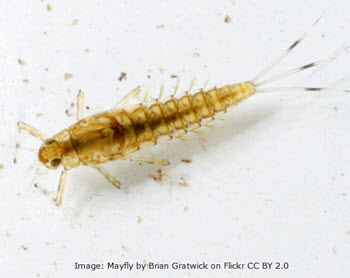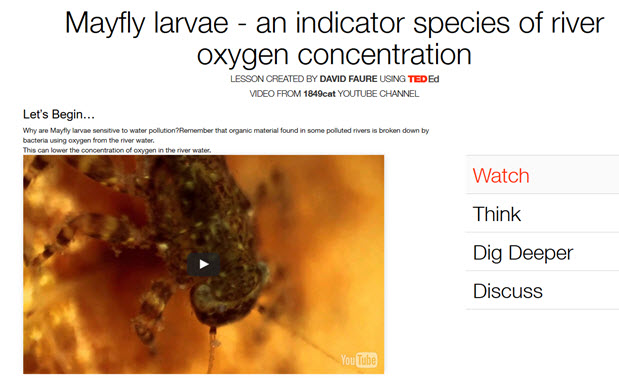Indicator species & biotic index
 Indicator species are species who can be easily identified and sampled and which are sensitive to some type of air pollution. There are many examples of such species including Lichens growing on trees and the larvae of Mayfly, Stonefly and Cadissfly. The presence and absence of groups of indicator species are sometimes combined into a system known as a biotic index. In this activity students will experience the use of two indicator species and a biotic index.
Indicator species are species who can be easily identified and sampled and which are sensitive to some type of air pollution. There are many examples of such species including Lichens growing on trees and the larvae of Mayfly, Stonefly and Cadissfly. The presence and absence of groups of indicator species are sometimes combined into a system known as a biotic index. In this activity students will experience the use of two indicator species and a biotic index.
Lesson Description
Guiding Question
What makes a good indicator species?

Indicator species should be:
- site specific
- unharmed by the sampling process
- easy to identify
- sensitive to specific pollutants
- distributed as widely as possible
Examples are:
- Blue mussels (Mytilus spp)
- Grizzly bears
- Lichens
- Benthic macro-invertebrates,
- Mayfly larva
- Stonefly larva
- Cadisfly larva
Activity 1 - Indicator Species
River quality has been evaluated since 1964 using the presence or absence of small animals living on the river bottom. These animals are called 'benthic macro-invertebrates" and one example is the mayfly larva.
Watch this video TEDEd Lesson showing how Mayfly larva obtain oxygen from river water
![]() Introduction to indicator species
Introduction to indicator species
Consider the oxygen uptake adaptations of the macro-invertebrates in the video. It shows benthic macro-invertebrates grouped according to their pollution tolerance. Could there be a correlation between oxygen uptake adaptations and pollution tolerance?
Thus is a nice summary presentation about ![]() Indicator species (Blue planet)
Indicator species (Blue planet)
Activity 2 - Calculation of Biotic Index - a simulation
In 2006 a group of IB students carried out a study of invertebrates on a river bed near to their school. They collected three samples of river invertebrates which they called A, B, and C using a standardized kick sampling method.
The ![]() Macro-invertebrate Identification worksheet will help students to identify the species.
Macro-invertebrate Identification worksheet will help students to identify the species.
Calculate one of the following biotic index values using the ![]() River samples to analyse from three samples A, B and C.
River samples to analyse from three samples A, B and C.
Beck's Biotic index - this is a nice method with a key to the different taxanomic groups.
![]() Simplified Biotic index calculations from field work simulation of a river study.
Simplified Biotic index calculations from field work simulation of a river study.
Activity 3 - Experiment to estimate air quality using lichen species on trees
The best way to find out about biotic indexes is to sample indicator species on a field trip. This simple experiment is an opportunity to do this in the school grounds.
Carry out experiment ![]() Lichens as indicator species of air pollution
Lichens as indicator species of air pollution
Teacher's notes
The main objectives of this lesson is to illustrate the usefulness of indicator species and to show how this is particularly helpful if the species are used to calculate a biotic index. There are three activites but not all of them need to be covered. However the first two could be set for homework if the class does the field work lab. Alternatively the third activity might be left out, as the theory is well covered in the other two activities.
The first activity tries to suggest that the capacity to absorb oxygen in benthic macro-invertebrates varies between different benthic species, and for this reason they are more or less tolerant of low oxygen levels which typically follow pollution by organic material.
![]() Washington state - kick sampling methodology video is quite long but thorough.
Washington state - kick sampling methodology video is quite long but thorough.
The second activity shows how this could work in practice using simple images of invertebrate samples and three options of biotic index. There are actually many different types.
Model answers for activity 2 - Biotic index can be found here: River pollution biotic index - model answers (Teacher can control student access to this page)
The third activity can take students outside in a simple investigation of lichens on trees to estimate sulfur dioxide concentration. This simplified table may be helpful.
Lichens and estimates of Sulfur dioxide pollution
This scale is adapted from the 'Hawksworth & Rose' zone scale. (http://www.air-quality.org.uk/19.php)
It can be used for the estimation of sulphur dioxide levels using lichens growing tree bark
Zone | Moderately acid bark | Mean winter SO2 (µg/m3) |
1 | Algae only, but confined to base. | >170 |
2 | Algae extends up the trunk; | about 150 |
3 | A green crust-like lichen extends up the trunk; | about 125 |
4 | Battleship green leaf like lichen and others appear on the bases but do not extend up the trunks. | about 70 |
5 | Several crust-like and leaf like lichens extend up the trunks and are also present on horizontal branches; | about 60 |
6 | A rich diversity of crust-like, leaf-like and branched lichen extend up the trunks, and onto horizontal branches. | about 50 |

 IB Docs (2) Team
IB Docs (2) Team

